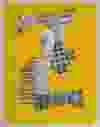From a wall of guts to bacterial blooms to a building facade, you’ll find plenty to appreciate in three dramatic new exhibitions that opened at Art Windsor-Essex this month.
Art
New AWE exhibits explore body issues, living matter, bridge art

Measuring 15 feet wide and 10.5 feet tall, Pageant of the Vulnerable turns fabric and recycled materials into bodily structures that visitors are allowed get close to and touch.
“It’s really incredible — and sort of gross,” said Jennifer Matotek, executive director of AWE. “(Hois) has made it super flesh-like. Some parts of it are softer, some parts of it are harder… It makes you very aware of your own body.”
Hois has described the piece as part of her therapeutic process dealing with issues such as body dysmorphia and an eating disorder.

Accompanying the organ wall is a setting called Heart House, which creepily recreates the living room of Hois’ childhood home — complete with a television.
The exhibit is viewable until May 28.

BioCurious
Plenty of artworks at AWE have been described as lively — but how about pieces that are actually living?
This exhibition gathers the works of 18 Canadian women artists with a unifying theme of exploring organic matters and life processes. Some of those explorations have resulted in putting actual ecosystems in the gallery.

For example, artist Lisa Hirmer’s contribution is a geodesic dome that houses living, oxygen-producing plants.
Artist Nicole Clouston put dirt samples into plexiglass containers and fed them bacteria — making blooms that will alter in colour over time.
Similarly, artist Maria Simmons collected materials from around the gallery itself and contained them with visibly reactive chemicals.

“Over the course of the exhibition — which is up to Oct. 1 — some of these pieces will grow and change,” Matotek noted.
Matotek said artist Jennifer Willett, whose work is a part of the exhibition, has deep experience with biological media in art and helped AWE with a safe containment plan for the show.

Cut-outs, Offcuts and Cast-offs
This exhibition by artist Sara Graham offers insight into the large-scale work she was commissioned to create for a building facade that’s part of the future Gordie Howe International Bridge.
Taking a multi-disciplinary approach, Graham drew from architecture, historical mapping, urban planning, and her own travels around the city to come up with her designs.
A scaled-down foam version of the building facade can be viewed in the exhibition, which is supported by the Windsor-Detroit Bridge Authority.
“The display is very much connected with the bridge project,” Matotek explained. “(Graham) has recreated her studio wall, which shows a lot of the inspiration, research, and process behind the design for the facade.”
The exhibit is viewable until May 28.
Art Windsor-Essex (401 Riverside Dr. West) is open Tuesday to Saturday from 10 a.m. to 5 p.m., Sundays from 11 a.m. to 5 p.m. Admission is $10 for the general public, free for AWE members and children under 6. Visit artwindsoressex.ca for more information.


Art
The art of the steal: Police investigate heist at Edmonton hospital – CBC.ca
[unable to retrieve full-text content]
The art of the steal: Police investigate heist at Edmonton hospital CBC.ca

Source link
Art
In search of art without an argument – Financial Times
[unable to retrieve full-text content]
In search of art without an argument Financial Times

Source link
Art
A misspelled memorial to the Brontë sisters gets its dots back at last

LONDON (AP) — With a few daubs of a paintbrush, the Brontë sisters have got their dots back.
More than eight decades after it was installed, a memorial to the three 19th-century sibling novelists in London’s Westminster Abbey was amended Thursday to restore the diaereses – the two dots over the e in their surname.
The dots — which indicate that the name is pronounced “brontay” rather than “bront” — were omitted when the stone tablet commemorating Charlotte, Emily and Anne was erected in the abbey’s Poets’ Corner in October 1939, just after the outbreak of World War II.
They were restored after Brontë historian Sharon Wright, editor of the Brontë Society Gazette, raised the issue with Dean of Westminster David Hoyle. The abbey asked its stonemason to tap in the dots and its conservator to paint them.
“There’s no paper record for anyone complaining about this or mentioning this, so I just wanted to put it right, really,” Wright said. “These three Yorkshire women deserve their place here, but they also deserve to have their name spelled correctly.”
It’s believed the writers’ Irish father Patrick changed the spelling of his surname from Brunty or Prunty when he went to university in England.
Raised on the wild Yorkshire moors, all three sisters died before they were 40, leaving enduring novels including Charlotte’s “Jane Eyre,” Emily’s “Wuthering Heights” and Anne’s “The Tenant of Wildfell Hall.”
Rebecca Yorke, director of the Brontë Society, welcomed the restoration.
“As the Brontës and their work are loved and respected all over the world, it’s entirely appropriate that their name is spelled correctly on their memorial,” she said.
The Canadian Press. All rights reserved.
-

 News8 hours ago
News8 hours agoFreeland says she is ‘absolutely confident’ Liberal MPs still support Trudeau |
-

 News8 hours ago
News8 hours agoTobacco victims hail ‘historic’ $32.5-billion deal |
-

 News10 hours ago
News10 hours ago‘Hateful and mean’: LGBTQ+ advocates slam Sask. Party’s proposed change room policy
-

 News8 hours ago
News8 hours agoThe NDP, B.C. Conservative leaders vie for votes ahead of Saturday’s election
-

 News10 hours ago
News10 hours agoWhere will B.C.’s election be won or lost? Here are five bellwether ridings to watch
-

 News10 hours ago
News10 hours agoFearing demolition, Montreal skateboarders rally to protect DIY skatepark from city
-

 News10 hours ago
News10 hours agoB.C. voters face a once-unthinkable election choice, after stunning rise of Rustad
-

 News10 hours ago
News10 hours agoVoters head to the polls today in Halifax and other Nova Scotia municipalities





















